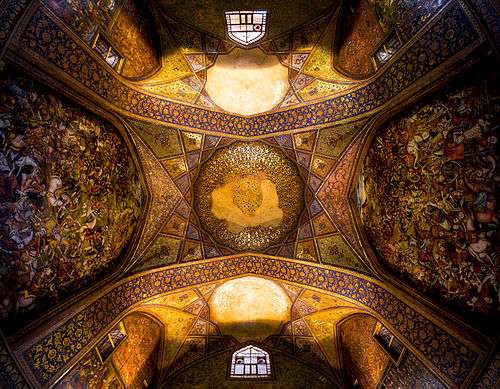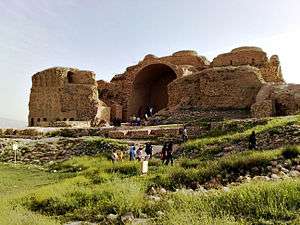Chehel Sotoun
Chehel Sotoun (Persian: چهل ستون, literally: “Forty Columns”) is a Persian pavilion in the middle of a park at the far end of a long pool, in Isfahan, Iran, built by Shah Abbas II to be used for his entertainment and receptions. In this palace, Shah Abbas II and his successors would receive dignitaries and ambassadors, either on the terrace or in one of the stately reception halls.
| UNESCO World Heritage Site | |
|---|---|
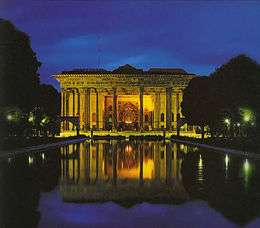 | |
| Location | Isfahan, Isfahan Province, Iran |
| Part of | The Persian Garden |
| Criteria | Cultural: (i)(ii)(iii)(iv)(vi) |
| Reference | 1372-003 |
| Inscription | 2011 (35th session) |
| Area | 5.8 ha (620,000 sq ft) |
| Buffer zone | 28.92 ha (3,113,000 sq ft) |
| Coordinates | 32°39′27″N 51°40′20″E |
 Location of Chehel Sotoun in Iran | |
The name, meaning "Forty Columns" in Persian, was inspired by the twenty slender wooden columns supporting the entrance pavilion, which, when reflected in the waters of the fountain, is said to appear to be forty.[1]
As with Ali Qapu, the palace contains many frescoes and paintings on ceramic. Many of the ceramic panels have been dispersed and are now in the possession of major museums in the west. They depict specific historical scenes such as the infamous Battle of Chaldiran against the Ottoman Sultan Selim I, the reception of an Uzbek King in 1646, when the palace had just been completed; the welcome extended to the Mughal Emperor, Humayun who took refuge in Iran in 1544; the battle of Taher-Abad in 1510 where the Safavid Shah Ismail I vanquished and killed the Uzbek King. A more recent painting depicts Nader Shah's victory against the Indian Army at Karnal in 1739. There are also less historical, but even more aesthetic compositions in the traditional miniature style which celebrate the joy of life and love.[2]
The Chehel Sotoun Palace is among the 9 Iranian Gardens which are collectively registered as one of the Iran’s 23 registered World Heritage Sites under the name of the Persian Garden.[3]
Gallery
 Muqarnas of Chehel Sotoun
Muqarnas of Chehel Sotoun- Day view of the palace
 Rear view of the palace
Rear view of the palace- Closer view of the palace
 A sculpture in the garden
A sculpture in the garden Golden muqarnas vaulting
Golden muqarnas vaulting Inside the museum
Inside the museum- The Qur'an in kufic script
 Fresco inside the palace
Fresco inside the palace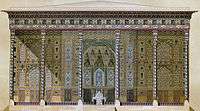 1840, by Pascal Coste
1840, by Pascal Coste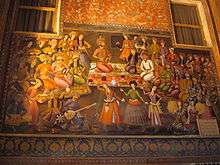 Fresco inside the palace
Fresco inside the palace.jpg) Artwork of the Battle of Chaldiran
Artwork of the Battle of Chaldiran Ceiling of Chehel Sotoun's mirror hall that contains Āina-kāri art
Ceiling of Chehel Sotoun's mirror hall that contains Āina-kāri art
Notes
- Landor, Arnold Henry Savage (1902). Across Coveted Lands. London: MacMillan and Co., Limited. p. 323.
- Honarfar, Lotfollah (1966). A Treasure of the Historical Monuments of Isfahan; Honarfar L. Isfahan: Saghafi.
- "Otraq.com, Iran's Tourism Guide"
Bibliography
- M. Ferrante: ‘Čihil Sutūn: Etudes, relevés, restauration’, Travaux de restauration de monuments historiques en Iran, ed. G. Zander (Rome, 1968), pp. 293–322
- E. Grube: ‘Wall Paintings in the Seventeenth Century Monuments of Isfahan’, Studies on Isfahan, ed. R. Holod, 2 vols, Iran. Stud., vii (1974), pp. 511–42
- S. Babaie: ‘Shah ‛Abbas II, the Conquest of Qandahar, the Chihil Sutun, and its Wall Paintings’, Muqarnas, xi (1994), pp. 125–42
External links
| Wikimedia Commons has media related to Chehel Sotoun. |
